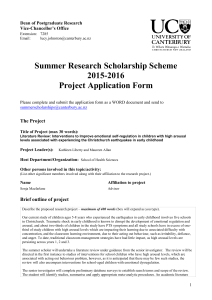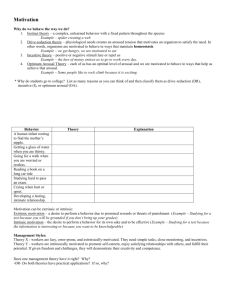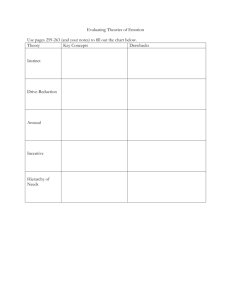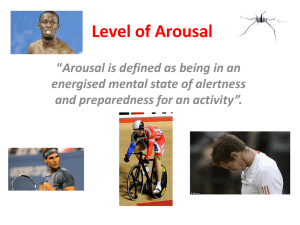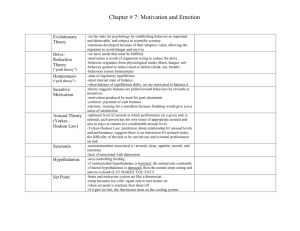ASSOCIATION FOR CONSUMER RESEARCH
advertisement
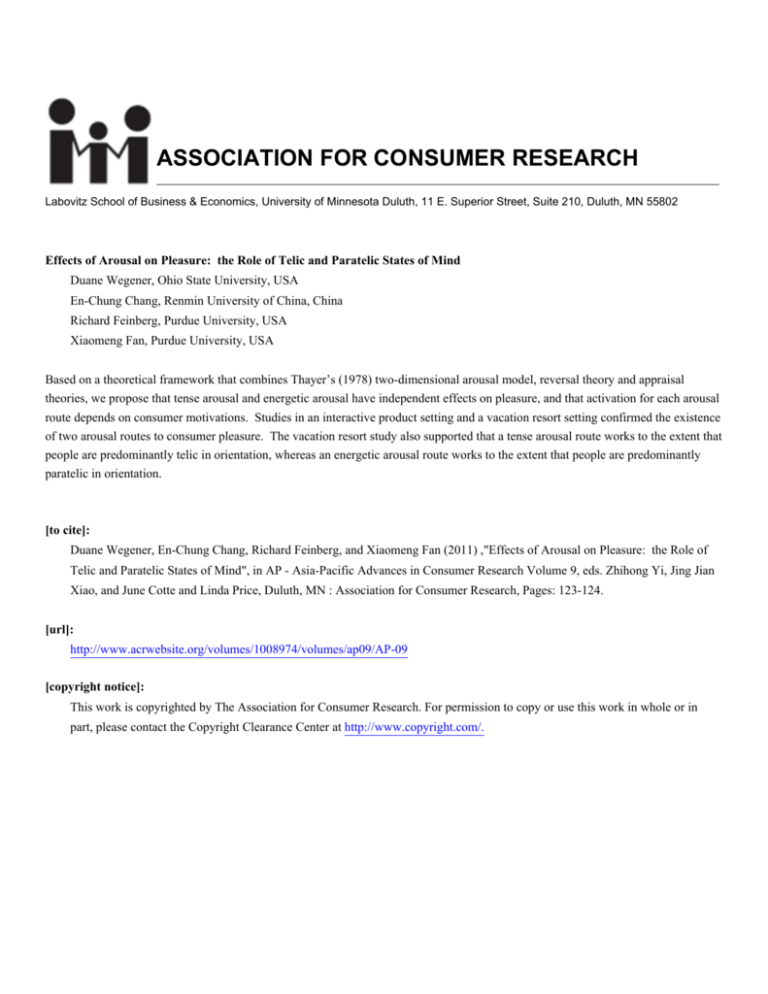
ASSOCIATION FOR CONSUMER RESEARCH Labovitz School of Business & Economics, University of Minnesota Duluth, 11 E. Superior Street, Suite 210, Duluth, MN 55802 Effects of Arousal on Pleasure: the Role of Telic and Paratelic States of Mind Duane Wegener, Ohio State University, USA En-Chung Chang, Renmin University of China, China Richard Feinberg, Purdue University, USA Xiaomeng Fan, Purdue University, USA Based on a theoretical framework that combines Thayer’s (1978) two-dimensional arousal model, reversal theory and appraisal theories, we propose that tense arousal and energetic arousal have independent effects on pleasure, and that activation for each arousal route depends on consumer motivations. Studies in an interactive product setting and a vacation resort setting confirmed the existence of two arousal routes to consumer pleasure. The vacation resort study also supported that a tense arousal route works to the extent that people are predominantly telic in orientation, whereas an energetic arousal route works to the extent that people are predominantly paratelic in orientation. [to cite]: Duane Wegener, En-Chung Chang, Richard Feinberg, and Xiaomeng Fan (2011) ,"Effects of Arousal on Pleasure: the Role of Telic and Paratelic States of Mind", in AP - Asia-Pacific Advances in Consumer Research Volume 9, eds. Zhihong Yi, Jing Jian Xiao, and June Cotte and Linda Price, Duluth, MN : Association for Consumer Research, Pages: 123-124. [url]: http://www.acrwebsite.org/volumes/1008974/volumes/ap09/AP-09 [copyright notice]: This work is copyrighted by The Association for Consumer Research. For permission to copy or use this work in whole or in part, please contact the Copyright Clearance Center at http://www.copyright.com/. Effects of Arousal on Pleasure: The Role of Telic and Paratelic States of Mind Xiaomeng Fan, Purdue University, USA* Duane Wegener, Ohio State University, USA En-Chung Chang, Renmin University of China, China* Richard Feinberg, Purdue University, USA EXTENDED ABSTRACT Arousal is a rather interesting phenomenon in consumption. Thayer (1978) suggested the existence of two bipolar dimensions of arousal -- energetic arousal (energysleep) and tense arousal (tension-calmness). Although Thayer‘s model was developed in the 1970s, little research has investigated whether arousal as two dimensions can influence consumer pleasure. Previous researchers have usually regarded arousal as a single dimension, which ranges from low (e.g., sleepy, calm) to high (e.g., exciting, tense) levels. However, the one-dimensional view of arousal cannot effectively reflect the independent effects of two kinds of arousal on pleasure. For example, consumer pleasure might be enhanced when tense arousal decreases (i.e., when people become more calm) and/or energetic arousal increases (i.e., when people become more excited). But reflected on a single continuum, arousal may not change following a reduction of tense arousal that accompanies an increase in energetic arousal. In this case, arousal from a one-dimensional view could not be identified as an antecedent of pleasure. This conclusion definitely neglects separate impacts of tense arousal and energetic arousal on pleasure. To address this deficiency and explain inconsistent findings regarding relations between arousal and pleasure in previous studies (Finn 2005; Kaltcheva and Weitz 2006; Ladhari 2007), the current study aims at validating the existence of two arousal routes to consumer pleasure. Thayer‘s two-dimensional view of arousal has been supported by reversal theory (Apter 2001). Reversal theory proposed two arousal curves. One was represented by relaxation-tension relating to an ―arousal avoiding‖ system, and the other by boredom-excitement as an ―arousal seeking‖ system. According to reversal theory, the ―arousal avoiding‖ and the ―arousal seeking‖ systems are respectively associated with two states of mind known as telic and paratelic (Walters, Apter, and Svebak 1982). The telic state is a serious-minded state in which an individual is goal-oriented. People in telic states value tranquility and calmness and avoid anxiety. In contrast, the paratelic state is a playful state that drives people to be activity-oriented. People in a paratelic state seek fun and stimulation in ongoing activities. Because tense and energetic arousals in Thayer‘s model are generally consistent with relaxation and excitement curves in reversal theory (Batra and Ray 1986; Brengman 2002; Larsen and Dienner 1992; Yik, Russell, and Feldman Barret 1999), the telic state should make people especially sensitive to tense arousal, and the paratelic state should make people especially sensitive to energetic arousal. According to reversal theory (Apter 2001), people in telic states value tranquility and avoid tension. Decreasing tense arousal in consumption experiences can enhance calm feelings, which directly meet the expectations of those who are predominantly telic. On the other hand, people in paratelic states desire to be stimulated and thrilled (Apter 2001). Increasing energetic arousal in consumption experiences can raise energetic states, which match the goals of paratelic-oriented people. Appraisal theories have indicated that goal congruence can result in pleasure (Johnson and Stewart 2004). Therefore, we hypothesize that calmness (low levels of tense arousal) would cause pleasure to the extent that people are predominately telic, and energy/vigor (high levels of energetic arousal) can lead to pleasure to the extent that people are predominately paratelic. We first tested the existence of two arousal routes to consumer pleasure in an interactive product context. One hundred and forty-one participants who had used a portable GPS in the last three months completed an online survey about consumer experiences with GPS devices. A regression on pleasure identified significant effects of ergonomic qualities (e.g. usability, controllability, and predictability) and hedonic qualities (e.g. fun, originality, and aesthetics). When calmness and energy/vigor were included as covariates in the prediction of pleasure, significant effects of calmness and energy/vigor emerged, and effects of ergonomic and hedonic qualities were reduced. In addition, ergonomic qualities significantly predicted calmness but not energy/vigor, and hedonic qualities significantly predicted energy/vigor but not calmness. Thus the effect of ergonomic qualities on pleasure was mediated by calmness and the effect of hedonic qualities was mediated by energy/vigor. Study 2 was about consumer experiences in vacation resort scenarios. This study was conducted to further test independent effects of tense arousal and energetic arousal on pleasure and also to test potential moderating effects of telic/paratelic orientations. Sixty-five participants were randomly assigned to one of two vacation scenarios (a vacation that requires high vs. low energy expenditure). They imagined themselves taking a vacation in a described scenario, and then indicated their feelings of arousal and pleasure. Finally, participants completed a personal style questionnaire (i.e. ―Paratelic Dominance Scale‖, Cook and Gerkovich 1993). Results indicated that a manipulation of energy expenditure significantly influenced both energetic and tense arousal: enhancing energy expenditure improved energy/vigor but reduced calmness. A regression on pleasure found positive main effects of calmness and energy/vigor, a positive interaction between energy/vigor and paratelic dominance score (PDS, a continuous variable), and a marginal negative interaction between calmness and PDS. Regression analyses showed that energy/vigor predicted pleasure for relatively paratelic-dominant people (1 SD above the mean on the PDS), but not for relatively telic-dominant people (1 SD below the mean on the PDS). Calmness influenced pleasure for both types of people, but the effect for relatively telicdominant people was greater than that for relatively paratelicdominant people. In sum, by establishing two arousal routes to pleasure, our research can clarify relations among product qualities, arousal and pleasure, and go beyond past work in consumer research that has equated pleasure with high-arousal affect 123 Asia Pacific Advances in Consumer Research Volume 9 © 2011 124 / Effects of Arousal on Pleasure: The Role of Telic and Paratelic States of Mind (e.g. elation). The two-arousal system can also be used by marketing practitioners to create more effective marketing mix programs according to the telic/paratelic orientations of targeted consumers. REFERENCES Apter, Michael J. (2001), Motivational Style in Everyday Life: A Guide to Reversal Theory. Washington, DC: APA. Batra, Rajeev and Michael L. Ray (1986), ―Affective Responses Mediating Acceptance of Advertising,‖ Journal of Consumer Research, 13 (September), 234-49. Brengman, Malaika (2002), ―The Impact of Colour in the Store Environment-An Environmental Psychology Approach,‖ unpublished dissertation, Ghent University, Brussels, Belgium. Cook, Mary R. and Mary M. Gerkovich (1993), ―The Development of A Paratelic Dominance Scale,‖ in Advances in Reversal Theory, ed. John H. Kerr and Michael. J. Apter, Amsterdam: Swets & Zeitlinger, 17788. Finn, Adam (2005), ―Reassessing the Foundations of Customer Delight,‖ Journal of Service Research, 8 (November), 103-16. Johnson, Allison R. and David W. Stewart (2004), ―A Reappraisal of the Role of Emotion in Consumer Behavior: Traditional and Contemporary Approaches,‖ in Review of Marketing Research, ed. Naresh. K. Malhotra , Armonk, New York: M.E. Sharpe, 1-33. Kaltcheva, Velitchka D. and Weitz, Barton A. (2006), ―When Should A Retailer Create An Exciting Store Environment,‖ Journal of Marketing, 70 (January), 10718. Ladhari, Riadh (2007), ―The Effect of Consumption Emotions on Satisfaction and Word-of-mouth Communications,‖ Psychology & Marketing, 24 (December), 1085-108. Larsen, Randy J., and Ed Diener (1992), ―Promises and Problems with Circumplex Model of Emotion,‖ in Review of Personality and Social Psychology: Emotion, Vol. 13, ed. M. S. Clark, Newbury Park, CA: Sage, 2559. Thayer, Robert E. (1978), ―Toward A Psychological Theory of Multidimensional Activation (Arousal),‖ Motivation and Emotion, 2(March), 1-34. Walters, Jean, Michael J. Apter, and Sven Svebak (1982), ―Color Preference, Arousal, and the Theory of Psychological Reversals,‖ Motivation and Emotion, 6(September), 193-215. Yik, Michelle S. M., James A. Russell, and Lisa Feldman Barrett (1999), ―Structure of Self-Reported Current Affect: Integration and Beyond,‖ Journal of Personality and Social Psychology, 77(September), 600-19.

